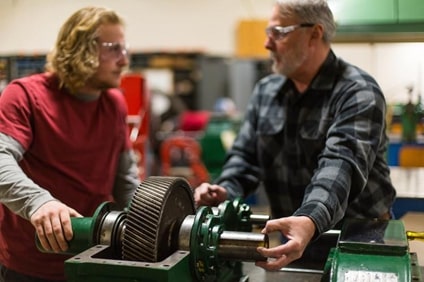How to Create an Effective Maintenance Plan?

Maintaining factory assets is vital to ensure the smooth operation of factories. Factories conduct maintenance of equipment to ensure everything works and nothing malfunctions. Keep in mind that preventing damage to factories and facilities is important. To pull this, well-thought-out schedules and plans need implementation.
An effective maintenance plan will result in efficient facilities. At the same time, this prevents more work downtime. A good plan lessens the expenses needed since you’ll know when to replace equipment or not. All factory operations will go orderly with well-thought-out maintenance planning and scheduling.
What is Maintenance Planning?
Implementing an effective maintenance planning and scheduling will not only save you costs on major repairs. It creates a domino effect from having productive equipment, to quality results, to saving money for your company, and more!
Maintenance planning is a process that identifies and solves possible issues in advance. This covers identifying the assets used for tasks. You will also check if these assets are in the right areas.
But, this is not limited to identifying key assets for the job. You will also handle extra tasks such as the following:
- Managing reserve parts
- Buying non-stock parts
- Managing expenses and vendor lists
- Quality-checking
What is Maintenance Scheduling?
Maintenance planning focuses on the assets used. Whereas the maintenance schedule is all about the timing of the planned work. It answers the questions of “when” and “who”. Who does this task and when is the deadline?
The main aim of maintenance scheduling is as follows:
- Scheduling of most work with available resources and assets
- Prioritization of work orders
- Scheduling preventive maintenance jobs if needed
- Cut the use of outside resources and maximize internal labor
The Advantages of Implementing the Plan
Well-thought-out planning and scheduling can bring a lot of benefits to your facilities. The first benefit is that budgeting is less of an issue. The next benefit is the lowering of work downtime. You will also have fewer spare parts. Last but not least, your facilities will have better workflow and maximized efficiency.
Consistency and Anticipation Are Key
Sometimes in factory work, equipment failure is inevitable. The best way to deal with potential setbacks is through preventive maintenance and regular inspections such as LEV Testing. You expect that the assets used for factory operations could break at any moment. Thus, preventive maintenance is very important since aged equipment can break down at any possible time.

Source:https://nmu.edu/tos/industrialmaintenance
Plant maintenance also needs you to set both urgent and non-urgent tasks. Urgent tasks are matters that need immediate attention to ensure workplace safety. Non-urgent tasks, while still important; can take care of them at a different time. Make sure to have a checklist ready and split these tasks as urgent or non-urgent.
You will use reliability assessments to identify assets that are still performing well. Over a while, you will check the quality of work that the factory instruments are providing. If the assets are still providing consistent outputs then keep them. Equipment reliability is very important if you want a smooth factory operation.
The Ideal maintenance Plan & Schedule
Forming an excellent maintenance plan & schedule is a step-by-step process. This requires a multitude of observations during a set period. From there, key personnel can determine which assets are the top priority.
Here are the key points to take note of:
- Detailing the work. You will identify first the assets that are a top priority. Then, you create the tasks for each factory asset, sorted by priority. Write down the procedures for the workers. Make sure that the procedures are clear, concise, and straight to the point.
- Set the work schedules. Set frequency, hours, and other time-related metrics. Again, priority comes into play when setting maintenance work schedules. Critical assets will need extra attention. Setting maintenance work schedules helps in predicting and preventing potential setbacks.
- Assign the work. Proper planning and scheduling also need you to assign the work to individuals that are fit for it. Set working hours for the maintenance task. Set work permits for the workers if it’s necessary. Give them a recap of the task for extra assurance.
- Stock up on spare parts. Not exactly a top but it is worth considering. You can stock up on spare parts now in preparation for potential setbacks. But, you can also stock up later on; after some factory observations. In the latter case, you would want to gather asset data first before buying spare parts.
You have to make sure not to omit any of the steps as it comes with consequences. You’ll have to also deal with less-experienced personnel from time to time. Make sure you don’t skip at step and double-check if necessary. You don’t want to have a maintenance plan that’s all over the place.
The whole idea of having a maintenance plan and schedule is to use preventive measures. You want to maintain the workflow while anticipating potential setbacks. At the same time, you are reducing the downtime of your facilities. What’s mentioned is achievable provided you didn’t skip any steps in the maintenance plan.
Set KPIs for Maintenance Work

SOURCE:https://www.pexels.com/photo/person-pointing-paper-line-graph-590041/
You cannot measure the success of your maintenance plan without key performance indicators. Set goals for the crew that’s in charge of maintenance work. But, a break in work happens from time to time and hinders the set plan. You will need to identify what causes this break in work and address it right away.
There are two common causes of breaks in work. First are tasks that are set to a priority higher than what it is. The second cause is the urge to hurry and rush the assigned task. Both of these breaks in work can bring consequences to your factory assets.
Once you’ve identified these breaks in work, you’ll need to work on a chart. You will plot the results on a weekly average. Aside from the breaks in work, you’ll have other factors to measure in, and these are:
- Percent of scheduled tasks done on time
- Percent of planned work, scheduling isn’t final
- Percent of compliance with preventive maintenance
- Percentage of work identified by key personnel (Examples are operators and predictive maintenance)
Conclusion
Working on an effective industrial maintenance plan is no easy work. You’ll need to identify key assets in your facility. After identifying the key assets, you’ll set the priorities. You are going to assign someone to a maintenance task and then set deadlines.
Make sure to expect any possible setbacks. You are going to observe the instruments over a period of time. You’ll also need to check key personnel performance. Do all steps and you’ll have a factory that operates with little to no issues.

